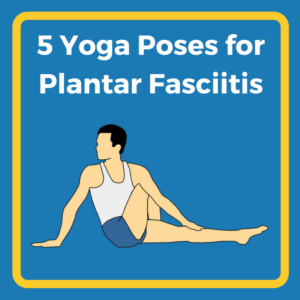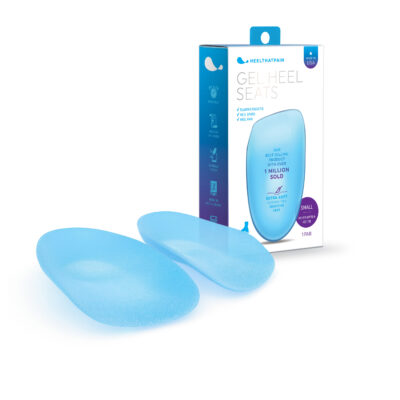 You’ve probably heard about the many health benefits of yoga by now–including flexibility, strength, and mental clarity.
You’ve probably heard about the many health benefits of yoga by now–including flexibility, strength, and mental clarity.
But did you know that yoga is also a great way to treat foot pain, including plantar fasciitis?
Yoga, which is a fusion of stretching, exercise, and mental awareness, is one of the oldest known forms of exercise and can be an excellent way to relieve heel pain, strengthen and stretch the foot muscles, and provide healthy low-impact exercise for people who suffer from plantar fasciitis.
Keep reading to learn about the benefits of yoga for plantar fasciitis, the best yoga stretches for heel pain, and how to maximize yoga for heel pain.
Benefits of Yoga for Plantar Fasciitis
Plantar fasciitis and yoga are a perfect match for a number of reasons:
Get in Touch With Your Body
Two of the most critical tenets of yoga include getting in tune with your body and strengthening your body–which are both great ways to approach plantar fasciitis! Recognizing when your body needs to rest as you exercise or go about your life is one of the biggest keys to avoiding and healing plantar fasciitis, since many instances of the condition are caused when the body has been pushed too far–leading to tearing or inflammation.
Improve Your Strength and Flexibility
Yoga centers heavily on stretching–which is one of the most effective ways to heal and strengthen damaged fascia! Stretching and strengthening the plantar fascia allows your arch to support weight and impact more effectively, reducing the likelihood of injury and allowing the different ligaments, muscles, and tendons in the feet and legs to support each other more effectively.
Improve Your Pain Without Expensive Medical Bills
Another benefit of doing yoga for heel pain is that the stretches and poses can be done from the comfort of your own home. An incredible 90% of plantar fasciitis cases can be healed without painful and invasive surgeries, procedures and medication. If you want to see even faster results at home, use yoga in combination with other natural remedies for plantar fasciitis to put your feet back on the path to healing faster than you can say “Bandhakonasana.”
Click here to get natural and 100% guaranteed heel pain inserts.

Best Yoga Stretches for Improving Plantar Fasciitis
As a general rule of thumb, you’ll want to stick with low impact stretches (most are!) and avoid stretches that put a lot of pressure on your arch or heels, or that require sudden movements.
Standing poses, poses that stretch calves and Achilles tendon, and poses that gently stretch the arches of your feet are ideal. The following are five of the very best yoga stretches for plantar fasciitis:
1. Toes Pose
This pose, found in Yin Yoga, targets the fascia of the body to stretch, strengthen, and elongate it.
To do Toes Pose, sit in a kneeling position. Then slowly lift up on your toes, with your knees still anchored in front of you on the ground. Gently let your weight settle back onto your heels, and hold this pose for between two and three minutes. Don’t get discouraged if this is difficult at first, or if you can’t hold the pose for this long. As you do this pose, imagine your fascia elongating and becoming more flexible. Don’t forget to breathe calmly and deeply through this pose.
2. Garland Pose
Garland pose stretches the ankles and calves for increased flexibility and strength in critical muscles that support your arch.
To do Garland pose, squat on the floor with your heels flat on the ground and your feet close together and your thighs apart. As you exhale, lean forward so that your torso fits between your thighs. Now, bring your hands together as you gently press your elbows against your inner knees. Hold this position for 30 seconds, then slowly release.
3. Tadasana (Mountain Pose)
Standing poses like this one are a great way to strengthen your legs and feet, stretch the fascia, and relax your body.
To do Tadasana, stand upright with your feet parallel and your big toes just barely touching. Lift the balls of your feet gently, then lower them back down. Rock your body side to side, then back and forth, finally coming to a standstill with your weight balanced across both feet.

4. Baddha Konasana (Bound Angle Pose)
This pose is great for people whose feet are fatigued and strained from spending a lot of time standing. Along with stretching the feet, it stretches the hips, thighs, and calves.
To do Bound Angle Pose, sit down and straighten your back. Then, bend your knees and bring them toward your pelvis until the soles of your feet touch. For support, you can hold your feet with your hands. Use your hands to pull your feet into your body as much as possible, then gently press your knees downward toward the floor. Hold for 1-3 minutes, release, and repeat. As you become more accustomed to this pose, you can increase the difficulty by slowly flapping your knees up and down, like a butterfly.

5. Prancing Feet Pose
This pose is great for building flexibility and strength in your fascia and toes.
To do Prancing Feet Pose, assume a basic standing position. Now, smoothly lift one heel off the ground and roll onto your toes. Place that foot back on the ground and repeat the motion with the opposite foot. Continue alternating sides in a fluid prancing motion. If you feel off balance, hold onto a table or back of a chair while you do Prancing Feet Pose.
How To Maximize Yoga for Heel and Foot Pain
Unlike aerobic exercises, which can put a great deal of strain and impact on your body (think of running, as a main example), yoga offers a low-impact way to stay in shape while improving your strength and flexibility.
If you suffer from heel pain, foot pain, or plantar fasciitis, keep the following tips in mind to maximize the experience for your needs!
Try a Yoga Class
While yoga does exist at a beginner’s level, it typically requires some fundamental knowledge about breathing, poses, and overall control of your body. As a result, we’d recommend starting with a yoga class, or a series of yoga classes. This will help you get acquainted with how yoga works, which will ultimately lead to maximum effectiveness for you.
Tell Your Instructor About Your Heel Pain
Don’t be afraid to let your teacher know that you suffer from plantar fasciitis or another form of heel pain if you decide to join a class! He or she will be able to help you know which exercises may be the most helpful, and which ones you should modify or avoid (like high-impact poses, or sudden pose changes).
Listen to Your Body
When doing a stretch or pose, don’t be afraid to stop if you encounter pain. Let your teacher know, and determine whether you should simply stop the stretch, or in some cases adjust how you’re doing the stretch. While some poses may feel strange at first, you should not feel pain! Listen to your body, and stick to the pace that’s right for you.
Use a Yoga Mat
If at all possible, use a cushioned mat to give your feet the most padding possible and reduce the amount of impact to your plantar fascia. You may want to consider purchasing your own yoga mat to bring with you to class, so you know you’ll have a plush, padded surface!
Choose Yoga Stretches That Focus on Your Feet and Heels
In terms of heel pain, yoga is most effective because of the stretching involved. Yoga stretches help the calf muscles and Achilles tendon remain loose, as well as strengthening the muscles in your feet.
The goal of each stretch in yoga involves releasing energy in the joints of your feet in order to break up scar tissue and adhesions, improve circulation, and increase strength and flexibility. All of this stretching helps with long-term relief from heel pain.
Ready to Give Yoga a Try?
Yoga can be a terrific way to treat your foot and heel pain, but remember that healing takes time. Regularly stretching and strengthening your plantar fascia will promote healing and will strengthen the surrounding muscles and ligaments, allowing your arch to better support weight and resist further injury.
Whether you decide to join a class or do yoga stretches in your own home, you can find motivation knowing that 90% of cases of plantar fasciitis can be treated without medical help. In other words, those relaxing mornings of yoga can make a big difference–without a big bill.
Whether you’re new to yoga or rediscovering the benefits of this helpful practice in a whole new light with plantar fasciitis, you’re taking a great step toward healing. Namaste!




Could you please make your words BOLDER and DARKER? For someone with eye problems, it is almost impossible to read.
Thank you,
Sorry you’ve had trouble reading it 🙁 We are always improving our design and appreciate your honest feedback. In the meantime, try zooming in further by clicking the “control” and “+” buttons at the same time if you are on Windows, and the “command” and “+” buttons if you are on Mac, and let us know if this makes it more readable!
Excellent poses I now know I need to do more of. Great explanation of the poses. Thank you for this.
I wish to see video instead.Thanks
Something that confuses me… podiatrists always tell me I should NEVER go barefoot with plantar fasciitis (even though it’s comfortable for me), so I’m afraid yoga will exacerbate the problem. Am I wrong?